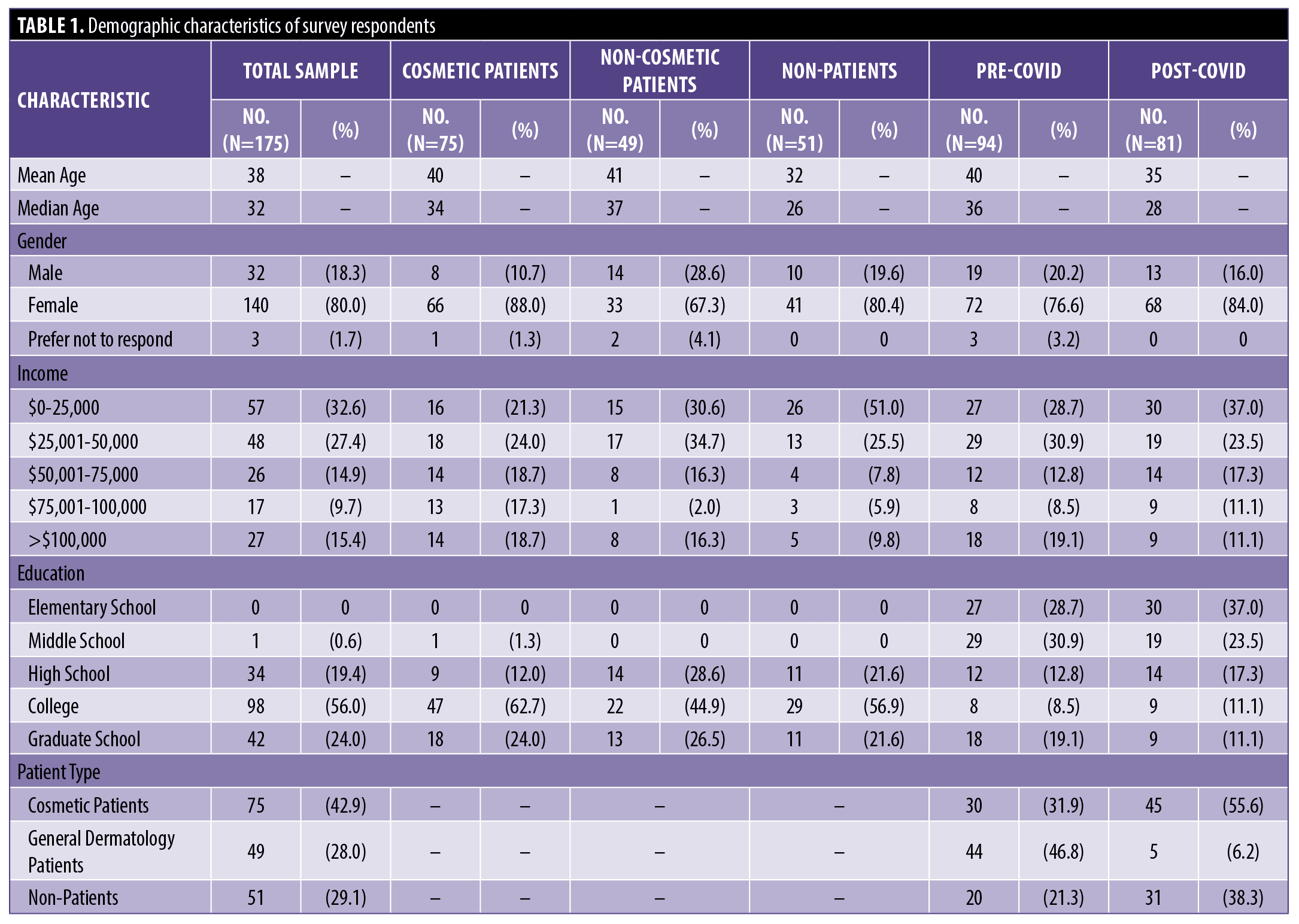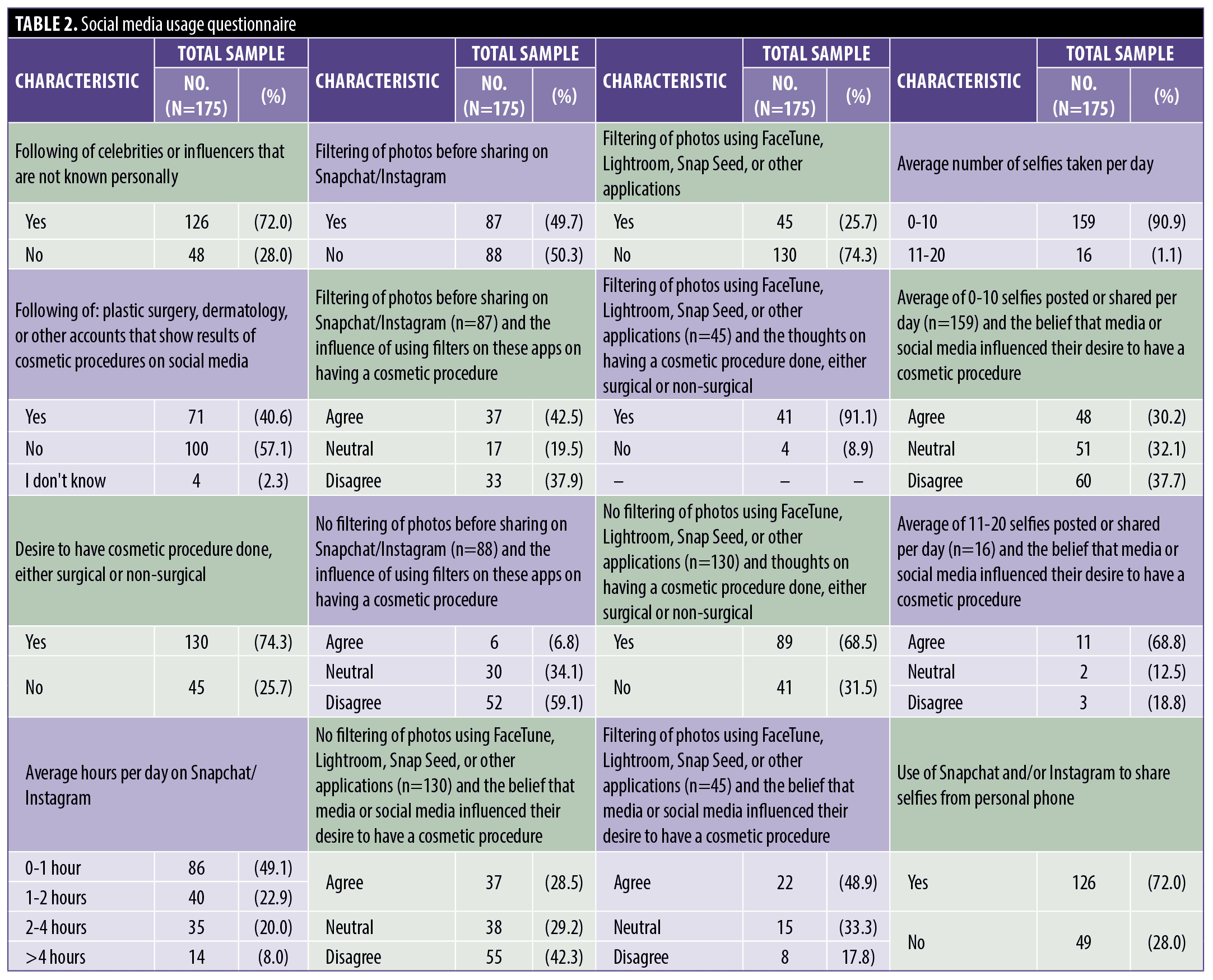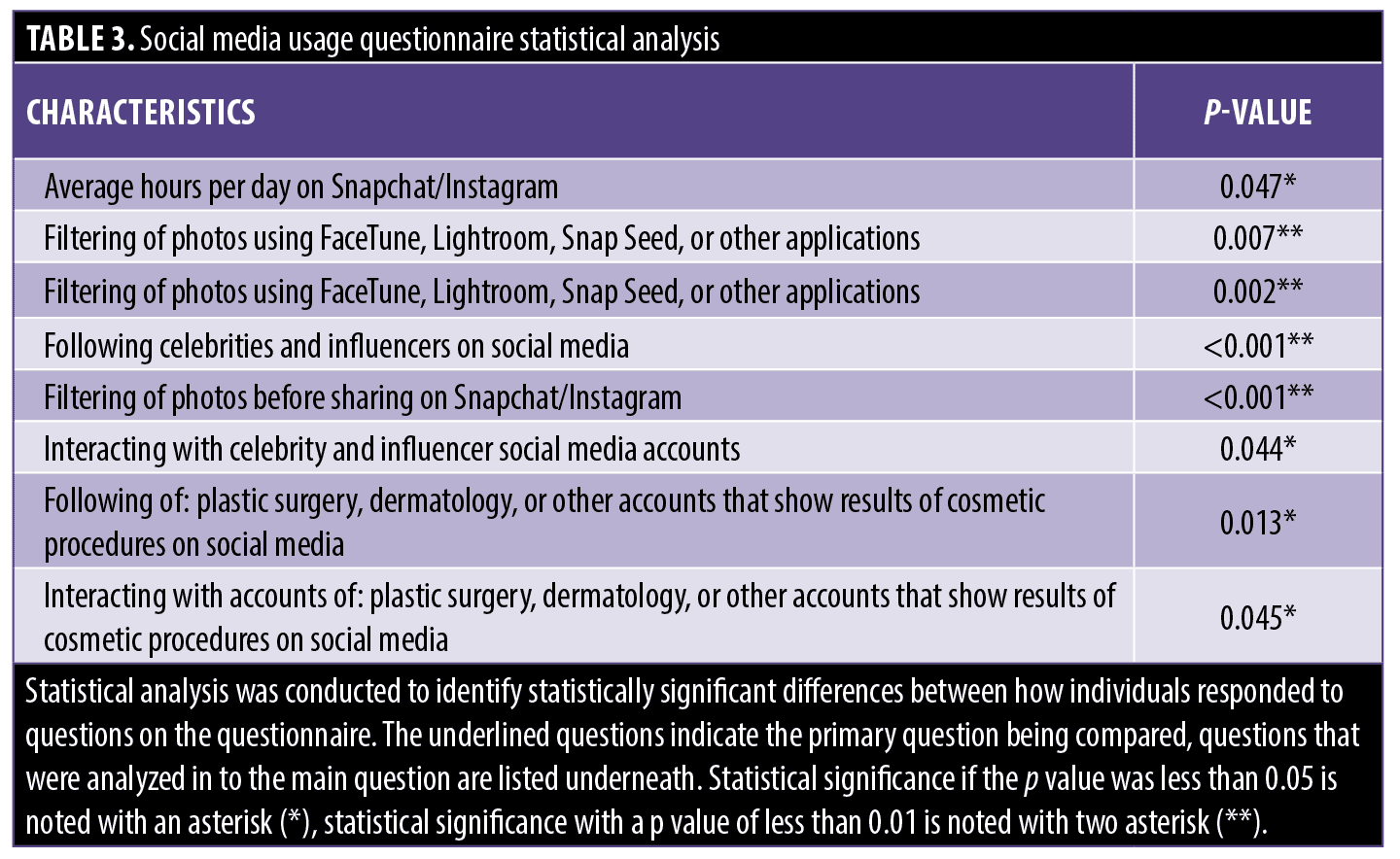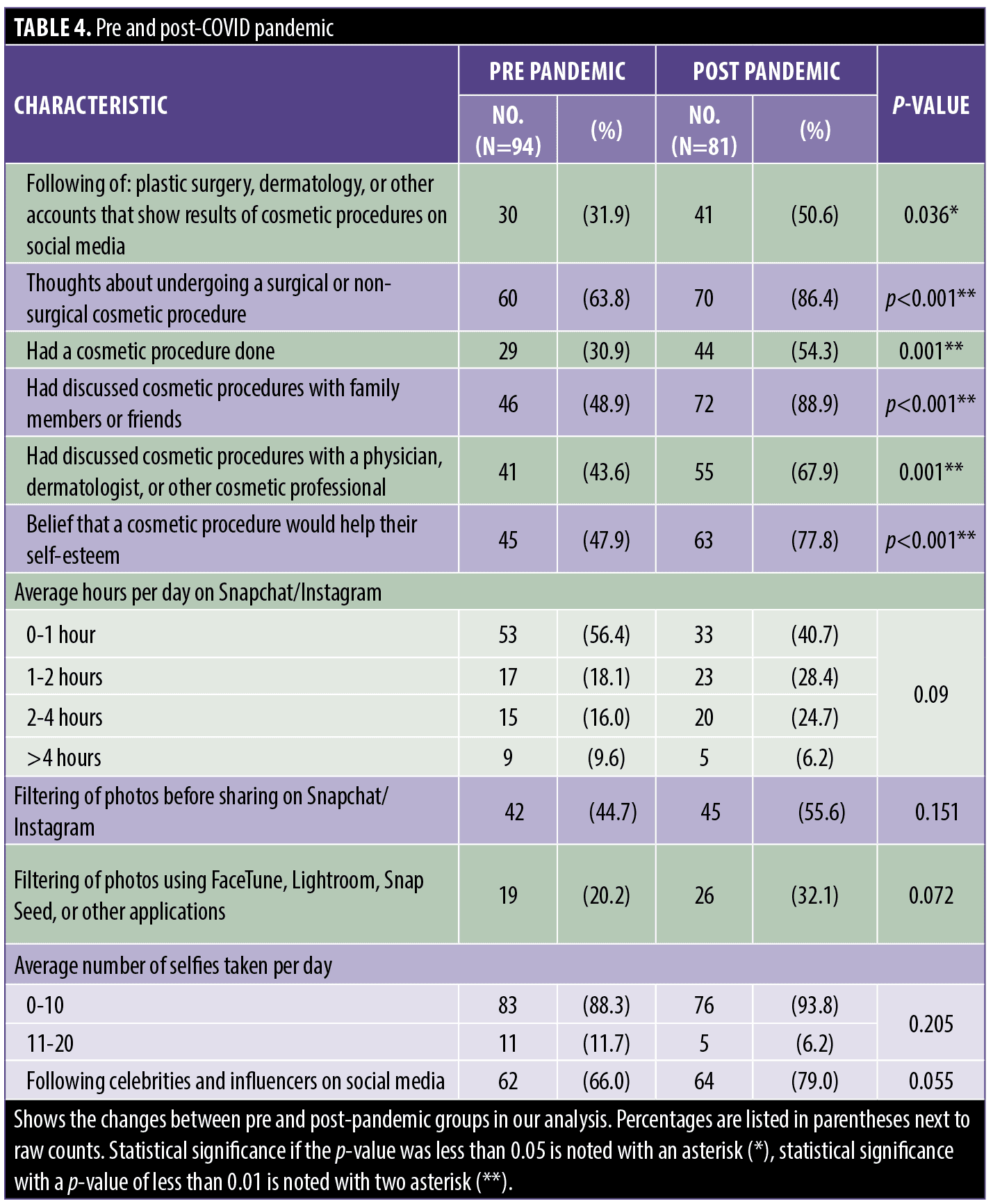 J Clin Aesthet Dermatol. 2024;17(3):42–47.
J Clin Aesthet Dermatol. 2024;17(3):42–47.
FUNDING: No funding was provided for this article.
DISCLOSURES: The authors have no conflicts of interest relevant to the contents of this article.
by Iman F. Khan, MD, MS, MPH; Henriette De La Garza, MD; Michelle Lazar, BS; Kevin F. Kennedy, MSc; and Neelam A. Vashi, MD
Drs. Khan, Garza, and Vashi along with Ms. Lazar are with the Department of Dermatology at the Boston University Chobanian and Avedisian School of Medicine in Boston, Massachusetts. Dr. Kennedy is with Saint-Luke’s Mid America Heart Institute and University of Missouri-Kansas City School of Medicine in Kansas City, Missouri.
ABSTRACT: Objective. We sought to explore facets of social media usage and the effect of the COVID-19 pandemic on the acceptance of cosmetic procedures.
Methods. At an outpatient dermatology clinic from October 2019 to June 2022, 175 subjects who were English and Spanish speaking and aged 18 years or older were recruited. Participants completed a questionnaire including demographic information, social media usage, perceptions of cosmetic procedures, and desire to have a cosmetic procedure. Results were grouped into a pre-COVID-19 pandemic group and post-COVID-19 pandemic group due to a natural experiment that arose. Data were analyzed to ascertain the effect of social media usage and other factors that impact desire to undergo a cosmetic procedure between patients before and after the COVID-19 pandemic.
Results. Factors resulting in differences in desire to have a cosmetic procedure included using photo editing applications (p=0.002), following celebrities and influencers on social media (p<0.001), and following social media accounts showing cosmetic results (p=0.013). There was a statistically significant change in number of participants that: followed social media accounts showing results of cosmetic procedures (pre-COVID: 31.9%, post-COVID: 50.6%, p=0.036); had thought about having a cosmetic procedure done (pre-COVID: 63.8%, post-COVID: 86.4%, p<0.001); had discussed cosmetic procedures with a physician, dermatologist, or other professional (pre-COVID: 43.6%, post-COVID: 67.9%, p=0.001); and believed that a cosmetic procedure would help their self-esteem (pre-COVID: 47.9%, post-COVID: 77.8%, p<0.001).
Limitations. Limitations of this study include response bias, recall bias, and single institution study design, limiting generalizability.
Conclusion. Our findings suggest that time spent on social media and use of photo-editing applications significantly contributes to desire to undergo a cosmetic procedure and contributed to the rise of cosmetic consultations during the COVID-19 pandemic.
Keywords: Social media, cosmetics, COVID-19, survey study, photo editing, body dysmorphia
Introduction
Social media platforms such as Snapchat and Instagram have been pivotal in perpetuating “selfie” culture, whereby an individual takes and shares a photo of themselves. Globally, social media usage has been increasing, with at least 3.5 billion using social media in 2019.1 As of 2018 the average adult was spending 6.3 hours per day on an internet connected device.1 A particularly troubling consequence of an increase in social media usage is the effect it has on body perception and self-esteem. Self-reported questionnaires completed by 101 grade-seven girls found that those who regularly shared photographs of themselves had higher body dissatisfaction and were more critical of their body as compared to peers who did not.2 However, social media can also have a positive impact, as indicated by a Cochrane review that found that specifically implemented social media programs could improve certain health behaviors, such as encouraging healthier diet choices or increasing levels of physical activity, by encouraging users to be more health conscious.3 Instances like these require purposeful alterations of how social media is typically used to ensure positive outcomes.
The angle of the “selfie” photographs taken for social media often distorts facial features in a way that leads to dissatisfaction.4 The pressure these apps generate is fueled by the advent of in-application and third-party filters that use artificial intelligence to alter facial features in both subtle and substantial ways. Medical professionals have reported a phenomenon of “Snapchat dysmorphia,” whereby patients seeking cosmetic procedures attempt to emulate filtered and edited versions of themselves.5,6 However, the filter effects and extensive photo manipulation often create images that are physically unattainable. Though decisions to obtain cosmetic procedures are complex, there is evidence to show that there is an association between the use of social media, photo editing applications, self-esteem, and cosmetic surgery acceptance. In fact, data shows a higher overall score on the Acceptance of Cosmetic Surgery Scale among users of certain social media applications, such as Snapchat.7 Those who score higher, and thus have an increased acceptance of cosmetic surgery, often have higher rates of interaction with certain social media apps. While this association is unlikely to be directly causative, it could be fueling some patients desires to seek treatment. Users who report using VSCO and Photoshop, commonly used photo editing applications, also have lower self-esteem scores than those who do not report using these applications.7–9 This highlights the fact that using certain social media apps may be directly harming individuals’ self-esteem and may lead them to pursue cosmetic procedures that they may have not otherwise have considered. Furthermore, recent studies show that spending more time on social media and manipulating photos is associated with higher levels of facial and body dissatisfaction.10,11
General screening to ascertain motivations and desired outcomes of patients seeking cosmetic procedures is commonplace. However, in the age of modern technology it is becoming just as important to screen patients for their social media usage and whether that is fueling decision making practices. This information is vital to both the provider and the patient, as it ensures open lines of communication and patient reflection. Given that social media usage increased during the COVID-19 pandemic, we sought to explore increased screen time on patient acceptance of cosmetic procedures.12,13 Through a natural experiment, our study was able to explore what facets of social media usage are associated with greater acceptance of cosmetic procedures, and to analyze the effect of the COVID-19 pandemic on the acceptance of cosmetic procedures.
Methods
Our study population consisted of individuals presenting to an ambulatory Dermatology clinic at an urban hospital in Boston between October 2019 and June 2021. The survey was offered in English and Spanish to individuals aged 18 years or older. Individuals were not eligible to participate if they were younger than 18 years old or did not speak English or Spanish as their primary language.
The questionnaire, with informed consent, consisted of demographics, social media usage, perceptions of cosmetic procedures, and desire to have a cosmetic procedure. In total, 175 surveys were collected. This study was approved by the Boston University Medical Campus Institutional Review Board (BUMC IRB H-39109) with collection beginning in October 2019, halting during the pandemic, and beginning again in March 2020 once the BUMC IRB allowed for resumption of human research.
Statistical analysis was conducted using SAS statistical software, Version 9.4 (SAS Institute Inc. 2013). Categorical variables were reported as counts and percentages, and continuous variables as means with standard deviations. Continuous variables were assessed via Student’s T-Tests, and categorical variables via Chi-squared analysis. A separate Chi-squared analysis was performed comparing pre-COVID patients, defined as all individual surveys collected before March 2020, and post-COVID patients, defined as all individual surveys collected after March 2020. From here on, “pre-COVID” and “post-COVID” will refer to these groups. These group timelines were determined by the hiatus imposed on human studies by the BUMC IRB and served as a natural experimental grouping.
Results
Demographics. A total of 175 participants completed our survey between October 2019 and June 2021. Of the respondents, the majority were women (140 [80.0%]), Hispanic White (52 [29.7%]), with a mean age of 32 (range 18-92), a college degree (98 [56.0%]), and presenting for a cosmetic dermatology visit (75, [42.9%]). Ninety-four of the patients (53.7%) were collected pre-COVID, and 81 (46.3%) were collected post-COVID (Table 1).
Social media usage. Of our total cohort, 89 (50.9%,) reported spending more than one hour on Snapchat or Instagram per day and 126 (72.0%) reported using Snapchat or Instagram to share selfies from their cellphone. Additionally, 87 (49.7%) reported filtering photos before sharing on Snapchat or Instagram, 45 (25.7%) reported editing photos on applications such as FaceTune, Lightroom or Snap Seed before sharing selfies, and 159 (90.9%) reported taking between 0 to 10 selfies, on average, per day. The majority of respondents (126, 72.0%) reported following celebrities and influencers on social media (Instagram, Snapchat, YouTube, Facebook) that they did not know personally, and 71 (40.6%) reported following plastic surgery, dermatology or other accounts that showed the results of cosmetic procedures on social media (Table 2).
We found that the number of hours individuals spent using Snapchat and/or Instagram every day had a statistically significant difference in the belief that media or social media had influenced their desire to have a cosmetic procedure done (p=0.047; 0-1 hour: Agree n=22, Neutral n=23, Disagree 41; 1-2 hours: Agree n=18, Neutral n=11, Disagree n=11; 2-4 hours: Agree n=13, Neutral n=15, Disagree n=7; 4+ hours: Agree n=6, Neutral n=4, Disagree n=4). Additionally, there was a statistically significant difference between filtering photos on Snapchat or Instagram before sharing selfies and the belief that using filters on Snapchat or Instagram had influenced their desire to have a cosmetic procedure done (p<0.001; Yes, filters selfies: Agree n=37, Neutral n=17, Disagree n=33; No, does not filter selfies: Agree n=6, Neutral n=30, Disagree n=52). Of the respondents who reported that they filter their photos on Snapchat or Instagram before sharing selfies, 37 (42.5%, n=87) agreed that using filters on Snapchat or Instagram had influenced their desire to have a cosmetic procedure. Conversely, only six (6.8%, n=88) of those who did not report using filters on Snapchat or Instagram before sharing selfies held similar beliefs (Table 3).
Furthermore, there was a statistically significant difference between the use of photo editing applications such as FaceTune, Lightroom, or Snap Seed to edit photos before sharing selfies on social media and thoughts about undergoing a surgical or non-surgical cosmetic procedure (p=0.002; Uses applications to edit photos: Thought about having a cosmetic procedure n=41, No thought of having a cosmetic procedure n=4; No use of applications to edit photos: Thought about having a cosmetic procedure n=89, No thought of having a cosmetic procedure n=41) and use of these applications and opinions on whether social media had influenced their desire to have a cosmetic procedure done (p=0.007; Uses applications to edit photos: Belief that social media has influenced their desire to have a cosmetic procedure: Agree n=22, Neutral n=15, Disagree n=8; Does not use applications to edit photos: Belief that social media has influenced their desire to have a cosmetic procedure: Agree n=37, Neutral n=38, Disagree n=55). Of the respondents who reported using applications to edit their photos before sharing their selfies, 41 (91.1%, n=45) reported they had thought about having a surgical or non-surgical cosmetic procedure. Comparatively, only 89 (68.5%, n=130) of participants who did not use these applications to edit their photos reported having thought about having a surgical or non-surgical cosmetic procedure. Additionally, 22 (48.9%, n=45) individuals who reported using photo editing applications before sharing their selfies reported that they believed that social media influenced their desire to have a cosmetic procedure done versus 37 (28.5%, n=130) who did not use these applications held the same belief (Table 3).
Of the respondents who reported that they take between 11-20 selfies a day, 11 (68.8%, n=16) believed that social media had influenced their desire to have a cosmetic procedure done compared to 48 (30.2%, n=159) of participants who held the same belief but reported taking between 0 to 10 selfies per day (Table 3).
Factors that resulted in significant differences in the desire to have a cosmetic procedure included: using photo-editing applications such as FaceTune, Lightroom, or Snap Seed before sharing (p=0.002; Use of photo editing applications: Thought about having a cosmetic procedure: Yes n=41, No n=4; No use of photo editing applications: Thought about having a cosmetic procedure: Yes n=89, No n=41), following celebrities and influencers on social media (p<0.001; Follows celebrities and influencers: Thought about having a cosmetic procedure: Yes n=103, No=23; Does not follow celebrities and influencers: Thought about having a cosmetic procedure: Yes n=27, No n=22); engaging with celebrity and influencer social media accounts (p=0.044; Engages with celebrities or influencers, Agree: Thought about having a cosmetic procedure: Yes n=36, No n=6; Engages with celebrities or influencers, Neutral: Thought about having a cosmetic procedure: Yes n=35, No n=20; Engages with celebrities or influencers, Disagree: Thought about having a cosmetic procedure: Yes n=59, No n=19); following plastic surgery, dermatology, or other accounts showing the results of cosmetic procedures on social media (p=0.013; Following plastic surgery, dermatology, or other accounts showing cosmetic results, Yes: Thought about having a cosmetic procedure: Yes n=61, No n=10; Following plastic surgery, dermatology, or other accounts showing cosmetic results, No: Thought about having a cosmetic procedure: Yes n=66, No n=34; Following plastic surgery, dermatology, or other accounts showing cosmetic results, Don’t know: Thought about having a cosmetic procedure done: Yes n=3, No n=1); and engaging with plastic surgery or dermatology accounts that showed the results of cosmetic procedures (p=0.045; Engage with plastic surgery or dermatology accounts that show cosmetic results, Agree: Thought about having a cosmetic procedure: Yes n=29, No n=3; Engage with plastic surgery or dermatology accounts that show cosmetic results, Neutral: Thought about having a cosmetic procedure: Yes n=27, No n=14; Engage with plastic surgery or dermatology accounts that show cosmetic results, Disagree: Thought about having a cosmetic procedure: Yes n=74, No n=28) (Table 3).
Pre- and post-pandemic analysis. There were 94 respondents in the pre-COVID group and 81 respondents in the post-COVID group. After the start of the COVID-19 pandemic, there was a statistically significant change in: number of participants who followed plastic surgery, dermatology, or other accounts that show the results of cosmetic procedures on social media (pre-COVID: 30 [31.9%] vs. post-COVID: 41 [50.6%] , p=0.036); had thought about having a surgical or non-surgical cosmetic procedure done (pre-COVID: 60 [63.8%] vs. post-COVID: 70 [86.4%] , p<0.001); ever had any cosmetic procedure done (pre-COVID: 29 [30.9%] vs. post-COVID: 44 [54.5%], p=0.001); had discussed cosmetic procedures with a family member or friend (46 [48.9%] vs. 72 [88.9%] , p<0.001); had discussed cosmetic procedures with physician, dermatologist, or other cosmetic professional (pre-COVID: 41 [43.6%] vs. post-COVID: 55 [67.9%], p=0.001); and believed that a cosmetic procedure would help their self-esteem (pre-COVID:45 [47.9%] vs post-COVID: 63 [77.8%], p<0.001) (Table 4).
Factors not associated with a significant change during the COVID-19 pandemic included: average number of hours using Snapchat and/or Instagram everyday (0-1 hour; pre-COVID: 53 (56.4%) vs. post-COVID: 33 (40.7%), 1-2 hours; pre-COVID: 17 (18.1%), post-COVID: 23 (28.4%), 2-4 hours; pre-COVID: 15 (16.0%) vs. post-COVID: 20 (24.7%), and more than four hours; pre-COVID: 9 (9.6%), post-COVID: 5 (6.2%), p=0.09); filtering photos on Snapchat or Instagram before sharing (pre-COVID: 42 [44.7%] vs. post-COVID: 45 [55.6%], p=0.151); using other applications such as FaceTune, Lightroom, or SnapSeed to edit photos before sharing selfies (pre-COVID: 19 [20.2%] vs. post-COVID: 26 [32.1%], p=0.072); number of selfies taken, on average, per day (0-10; pre-COVID: 83 (88.3%) vs. post=COVID: 76 (93.8%), 11-20; pre-COVID: 11 (11.7%), vs. post-COVID: 5 (6.2%), p=0.205); and following celebrities and influencers on social media that they did not know personally (pre-COVID: 62 [66.0%, n=94] vs. 64 [79.0%], p=0.055) (Table 4).
Discussion
We sought to explore the facets of social media usage associated with greater acceptance of cosmetic procedures. Our data suggest that time spent on social media (Snapchat and/or Instagram), usage of filters on these applications, and the use of third-party editing applications influences the desire to have a cosmetic procedure done, which is consistent with previous published data on the topic.7 Furthermore, following and engaging with celebrities and influencers on social media, as well as following and engaging with plastic surgery, dermatology, or other accounts showing the results of cosmetic procedures on social media significantly influences desire to have a cosmetic procedure done. While social media use most likely does not directly cause patients to pursue cosmetic procedures, it may make those who were already considering procedures more likely to undergo them by increasing their exposure through direct-to-consumer advertising. These data may be explained by the ability of cosmetic practices, medical professionals, and social media influencers to widely disseminate information and advertise cosmetic procedures directly to patients through social media.14 By doing so, social media is able to assist in converting the everyday consumer into a prospective patient. Dermatologists and plastic surgeons should discuss social media use with patients and attempt to understand its influence on their expectations of a cosmetic result. Content that is produced online will only indicate selective outcomes, and conversations regarding timelines to realistic expectations must be had.
Through our naturally conducted experiment, we also sought to determine the effects of the COVID-19 pandemic on the acceptance of cosmetic procedures within our study population. We found significant differences in the number of participants following plastic surgery, dermatology, or other accounts showing the results of cosmetic procedures; participants with thoughts about having cosmetic procedures done; participants who had ever had a cosmetic procedure done; participants who had discussed a cosmetic procedure with a physician, dermatologist, or other cosmetic professional; and participants who agreed that a cosmetic procedure would help their self-esteem. Our results are consistent with provider perspectives reporting an increase in patients seeking cosmetic consultations during the COVID-19 pandemic compared with prior to the pandemic.15 While there are many factors that likely contribute to this, social media usage did likely increase the desire, amongst a subset of patients, to seek cosmetic procedures. The average number of hours using Snapchat and/or Instagram every day, number of selfies taken per day, filtering photos on these platforms, and using third-party applications to filter photos did not significantly change in our pre- and post-COVID pandemic groups, contrary to our belief that patients would have more time and desire to engage in these activities during the pandemic. Therefore, it seems that the direct effect of social media usage may not be mediated through time spent but rather, interacted content. Similar to the previously described “Snapchat Dysmorphia,” plastic surgeons and dermatologists noticed a growing trend of “Zoom Dysmorphia” as a result of staring at distorted images produced by front-facing cameras for prolonged periods of time.15 This is corroborated by data demonstrating that increased video call utilization is associated with higher acceptance of cosmetic surgery by patients.16 As our world continues to shift to including more virtual components, it is more likely that these numbers will only increase. Therefore, it is of the utmost importance that those who practice aesthetic medicine identify these ongoing changes and the effect they may have on future patients and alter their screening regimes and conversations with patients to ensure the best care is provided. In addition to time on social media and video conferencing platforms, other explanations for an increase in cosmetic consultations include ease of scheduling and attending appointments, as well as the privacy to recover discreetly and without using paid time off during the work-from-home era.17–19 Many popular cosmetic procedures have at least some down time, and with the switch to remote work many patients were able to continue working while recovering away from the public eye. As multiple studies have established the link between social media usage, photo editing, body dissatisfaction, and low self-esteem,7,10,11 future studies should explore the association between social media use, photo editing, seeking of cosmetic procedures, and the likelihood of body dysmorphia diagnosis. These are issues that will continue to be important for providers and will likely increase in the impact they have on patients as younger generations age into adulthood, having their entire childhood and formative years spent with social media existing.
Limitations of this study include response bias, recall bias, and single institution study design, limiting generalizability. However, our data does align with other studies about the impact of the COVID pandemic on social media usage and the desire for cosmetic enhancement. Therefore, it may serve as an additional explanation for what occurred during the COVID pandemic in terms of cosmetic procedure attainment.
Conclusion
Our findings suggest that time spent on social media platforms as well as the usage of filters and third-party editing applications are contributors to the desire to attain a cosmetic procedure. We advise that cosmetic practitioners discuss social media and video platform usage with their patients to understand their desire for a cosmetic procedure as well as their anticipated results. The usage of social media will only continue; therefore, medicine must adapt to coexist so we can effectively serve patients.
References
- Blume-Peytavi U, Kanti V. Androgenetic alopecia. Ortiz-Ospina E. The rise of social media. Our World in Data. Published September 18, 2019. https://ourworldindata.org/rise-of-social-media
- McLean SA, Paxton SJ, Wertheim EH, Masters J. Photoshopping the selfie: Self photo editing and photo investment are associated with body dissatisfaction in adolescent girls. Int J Eat Disord. 2015;48(8):1132–1140.
- Petkovic J, Duench S, Trawin J, et al. Behavioural interventions delivered through interactive social media for health behaviour change, health outcomes, and health equity in the adult population. Cochrane Database of Systematic Reviews 2021, Issue 5. Art. No.: CD012932.
- Pressler MP, Kislevitz ML, Davis JJ. Size and Perception of Facial Features with Selfie Photographs, and Their Implication in Rhinoplasty and Facial Plastic Surgery. Plast Reconstr Surg. 2022 Apr 1;149(4):859–867.
- Hosie R. More people want surgery to look like a filtered version of themselves rather than a celebrity, cosmetic doctor says. Independent [Internet]. 2018 Feb 6. https://www.independent.co.uk /life-style/cosmetic-surgery-snapchat-instagram -filters-demand-celebrities-doctor-dr-esho -london-a8197001.html. Accessed February 27, 2018.
- Rajanala S, Maymone MBC, Vashi NA. Selfies—living in the era of filtered photographs. JAMA Facial Plast Surg. 2018;20(6):443–444.
- Chen J, Ishii M, Bater KL, et al. Association Between the Use of Social Media and Photograph Editing Applications, Self-esteem, and Cosmetic Surgery Acceptance. JAMA Facial Plast Surg. Published online June 27, 2019.
- Adobe Inc. (2023). Adobe Photoshop. Retrieved from: https://www.adobe.com/products/photoshop.html
- VSCO Co. (2023). VSCO. Retrieved from https://www.vsco.co/
- Ward B, Ward M, Fried O, et al. Nasal Distortion in Short-Distance Photographs: The Selfie Effect. JAMA Facial Plast Surg. 2018;20(4):333-335.
- Yang J, Fardouly J, Wang Y, et al. Selfie-Viewing and Facial Dissatisfaction among Emerging Adults: A Moderated Mediation Model of Appearance Comparisons and Self-Objectification. Int J Environ Res Public Health. 2020;17(2):672. Published 2020 Jan 20.
- Williamson DA. US social media usage. Insider Intelligence [Internet]. https://www.insiderintelligence.com/content/us-social-media-usage. 2020 June 2. Accessed July 25, 2022.
- Molla R. Posting less, posting more, and tired of it all: How the pandemic has changed social media. Vox [Internet]. https://www.vox.com/recode/22295131/social-media-use-pandemic-covid-19-instagram-tiktok. 2021 Mar 1. Accessed July 25, 2022.
- Gupta N, Dorfman R, Saadat S, et al. The Plastic Surgery Social Media Influencer: Ethical Considerations and a Literature Review. Aesthet Surg J. 2020;40(6):691–699.
- Rice SM, Siegel JA, Libby T, et al. Zooming into cosmetic procedures during the COVID-19 pandemic: The provider’s perspective. Int J Womens Dermatol. 2021;7(2):213–216. Published 2021 Jan 12.
- Chen J, Chow A, Fadavi D, et al. The Zoom Boom: How Video Calling Impacts Attitudes Towards Aesthetic Surgery in the COVID-19 Era. Aesthet Surg J. 2021;41(12):NP2086-NP2093.
- Sharma GK, Asaria J. The Impact of COVID-19 on Patient Interest in Facial Plastic Surgery. Plast Reconstr Surg Glob Open. 2021;9(10):e3890. Published 2021 Oct 22.
- Drew J. Davis MD. How working from home is fueling a desire for facial plastic surgery. https://www.plasticsurgery.org/news/blog/how-working-from-home-is-fueling-a-desire-for-facial-plastic-surgery. American Society of Plastic Surgeons [Internet]. 2021 Oct 7. Accessed July 25, 2022.
- Imam SZ, Karanasios G, Khatib M, et al. Resumption of Cosmetic Surgery During COVID – Experience of a Specialised Cosmetic Surgery Day-case Hospital. J Plast Reconstr Aesthet Surg. 2021;74(11):3178-3185.





